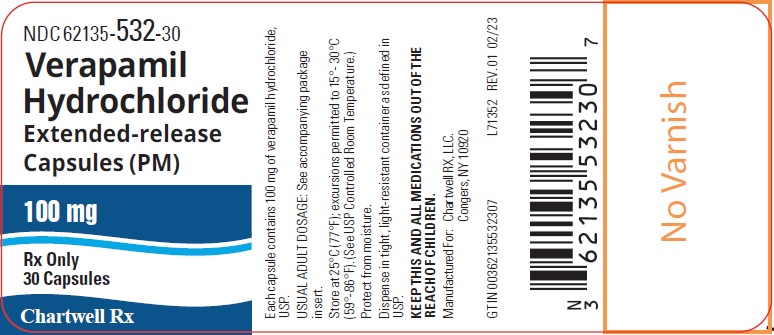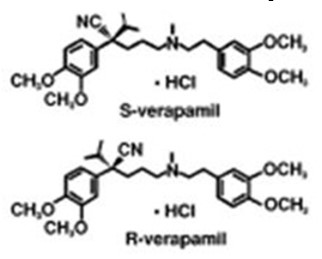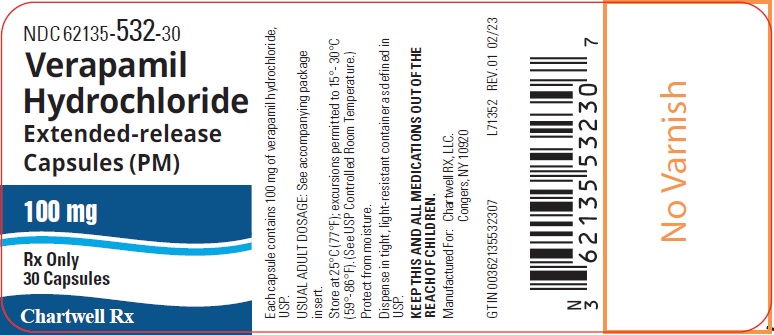7.1 CYP3A4 Inhibitors and Inducers
-
In vitro metabolic studies indicate that verapamil is metabolized by cytochrome P450, CYP3A4, CYP1A2, and CYP2C. Clinically significant interactions have ...
7.1 CYP3A4 Inhibitors and Inducers
In vitro metabolic studies indicate that verapamil is metabolized by cytochrome P450, CYP3A4, CYP1A2, and CYP2C. Clinically significant interactions have been reported with inhibitors of CYP3A4 (e.g., erythromycin, ritonavir) causing elevation of plasma levels of verapamil. Hypotension, bradyarrhythmias, and lactic acidosis have been observed in patients receiving concurrent telithromycin, an antibiotic in the ketolide class of antibiotics. Inducers of CYP3A4 (e.g., rifampin) have caused a lowering of plasma levels of verapamil.
Ivabradine
Concurrent use of verapamil increases exposure to ivabradine and may exacerbate bradycardia and conductions disturbances. Avoid concomitant use of ivabradine and verapamil.
7.2 HMG-CoA Reductase Inhibitors
The use of HMG-CoA reductase inhibitors that are CYP3A4 substrates in combination with verapamil has been associated with reports of myopathy/rhabdomyolysis.
Co-administration of multiple doses of 10 mg of verapamil with 80 mg simvastatin resulted in exposure to simvastatin 2.5-fold that following simvastatin alone. Limit the dose of simvastatin in patients on verapamil to 10 mg daily. Limit the daily dose of lovastatin to 40 mg. Lower starting and maintenance doses of other CYP3A4 substrates (e.g., atorvastatin) may be required as verapamil may increase the plasma concentration of these drugs.
7.3 Grapefruit Juice
Grapefruit juice may significantly increase concentrations of verapamil. Grapefruit juice given to nine healthy volunteers increased S- and R- verapamil AUC 0-12 by 36% and 28%, respectively. Steady state C
max and C
min of S-verapamil increased by 57% and 16.7%, respectively with grapefruit juice compared to control. Similarly, C
max and C
min of R-verapamil increased by 40% and 13%, respectively. Grapefruit juice did not affect half-life, nor was there a significant change in AUC 0-12 ratio R/S compared to control. Grapefruit juice did not cause a significant difference in the pharmacokinetics of norverapamil. This increase in verapamil plasma concentration is not expected to have any clinical consequences.
7.4 Beta Blockers
Concomitant therapy with beta-adrenergic blockers and verapamil may result in additive negative effects on heart rate, atrioventricular conduction, and/or cardiac contractility. The combination of extended-release verapamil and beta-adrenergic blocking agents has not been studied. However, there have been reports of excess bradycardia and AV block, including complete heart block, when the combination has been used for the treatment of hypertension. For hypertensive patients, the risk of combined therapy may outweigh the potential benefits. The combination should be used only with caution and close monitoring. Asymptomatic bradycardia (36 beats/min) with a wandering atrial pacemaker has been observed in a patient receiving concomitant timolol (a beta-adrenergic blocker) eyedrops and oral verapamil.
A decrease in metoprolol and propranolol clearance has been observed when either drug is administered concomitantly with verapamil. A variable effect has been seen when verapamil and atenolol were given together.
7.5 Digitalis
Consider reducing digoxin dose when verapamil and digoxin are to be given together. Monitor digoxin level periodically during therapy. Chronic verapamil treatment can increase serum digoxin levels by 50% to 75% during the first week of therapy, and this can result in digitalis toxicity. In patients with hepatic cirrhosis the influence of verapamil on digoxin pharmacokinetics is magnified. Verapamil may reduce total body clearance and extrarenal clearance of digoxin by 27% and 29%, respectively. If digoxin toxicity is suspected, suspend or discontinue digoxin therapy.
In previous clinical trials with other verapamil formulations related to the control of ventricular response in patients taking digoxin who had atrial fibrillation or atrial flutter, ventricular rates below 50/min at rest occurred in 15% of patients, and asymptomatic hypotension occurred in 5% of patients.
7.6 Alcohol
Verapamil has been found to significantly inhibit ethanol elimination resulting in elevated blood ethanol concentrations that may prolong the intoxicating effects of alcohol.
7.7 Clonidine
Sinus bradycardia resulting in hospitalization and pacemaker insertion has been reported in association with the use of clonidine concurrently with verapamil. Monitor heart rate in patients receiving concomitant verapamil and clonidine.
7.8 Telithromycin
Hypotension and bradyarrhythmias have been observed in patients receiving concurrent telithromycin, an antibiotic in the ketolide class of antibiotics.
7.9 Antineoplastic Agents
Verapamil can increase doxorubicin levels. The absorption of verapamil can be reduced by the cyclophosphamide, oncovin, procarbazine, prednisone (COPP) and the vindesine, adriamycin, cisplatin (VAC) cytotoxic drug regimens. Concomitant administration of R verapamil can decrease the clearance of paclitaxel.
7.10 Quinidine
In a small number of patients with hypertrophic cardiomyopathy, concomitant use of verapamil and quinidine resulted in significant hypotension. Until further data are obtained, avoid combined therapy of verapamil and quinidine in patients with hypertrophic cardiomyopathy.
The electrophysiological effects of quinidine and verapamil on AV conduction were studied in 8 patients. Verapamil significantly counteracted the effects of quinidine on AV conduction. There has been a report of increased quinidine levels during verapamil therapy.
7.11 Aspirin
In a few reported cases, coadministration of verapamil with aspirin has led to increased bleeding times greater than observed with aspirin alone.
7.12 Antihypertensive Agents
Verapamil administered concomitantly with oral antihypertensive agents (e.g., vasodilators, angiotensin-converting enzyme inhibitors, diuretics, beta blockers) will usually have an additive effect on lowering blood pressure. Monitor patients receiving these combinations appropriately. Concomitant use of agents that attenuate alpha-adrenergic function with verapamil may result in reduction in blood pressure that is excessive in some patients. Such an effect was observed in one study following the concomitant administration of verapamil and prazosin.
7.13 Disopyramide
Until data on possible interactions between verapamil and disopyramide are obtained, do not administer disopyramide within 48 hours before or 24 hours after verapamil administration.
7.14 Flecainide
A study in healthy volunteers showed that the concomitant administration of flecainide and verapamil may have additive effects on myocardial contractility, AV conduction, and repolarization. Concomitant therapy with flecainide and verapamil may result in additive negative inotropic effect and prolongation of atrioventricular conduction.
7.15 Carbamazepine
Verapamil therapy may increase carbamazepine concentrations during combined therapy. This may produce carbamazepine side effects such as diplopia, headache, ataxia, or dizziness.
7.16 Cyclosporine
Verapamil therapy may increase serum levels of cyclosporine.
7.17 Lithium
Increased sensitivity to the effects of lithium (neurotoxicity) has been reported during concomitant verapamil-lithium therapy with either no change or an increase in serum lithium levels. However, the addition of verapamil has also resulted in the lowering of serum lithium levels in patients receiving chronic stable oral lithium. Patients receiving both drugs must be monitored carefully.
7.18 Inhalation Anesthetics
Animal experiments have shown that inhalation anesthetics depress cardiovascular activity by decreasing the inward movement of calcium ions. When used concomitantly, inhalation anesthetics and calcium antagonists, such as verapamil, titrate slowly to avoid excessive cardiovascular depression.
7.19 Neuromuscular Blocking Agents
Clinical data and animal studies suggest that verapamil may potentiate the activity of neuromuscular blocking agents (curare-like and depolarizing). It may be necessary to decrease the dose of verapamil and/or the dose of the neuromuscular blocking agent when the drugs are used concomitantly.
7.20 Phenobarbital
Phenobarbital therapy may increase verapamil clearance.
7.21 Rifampin
Therapy with rifampin may markedly reduce oral verapamil bioavailability.
7.22 Theophylline
Verapamil may inhibit the clearance and increase the plasma levels of theophylline.
7.23 Cimetidine
The interaction between cimetidine and chronically administered verapamil has not been studied. Variable results on clearance have been obtained in acute studies of healthy volunteers; clearance of verapamil was either reduced or unchanged.
7.24 Nitrates
Verapamil has been given concomitantly with short- and long-acting nitrates without any undesirable drug interactions. The pharmacologic profile of both drugs and the clinical experience suggest beneficial interactions.
7.25 Mammalian Target of Rapamycin (mTOR) Inhibitors
In a study of 25 healthy volunteers with co-administration of verapamil with sirolimus, whole blood sirolimus C
max and AUC were increased 130% and 120%, respectively. Plasma S(-) verapamil C
max and AUC were both increased 50%. Co-administration of verapamil with everolimus in 16 healthy volunteers increased the C
max and AUC of everolimus by 130% and 250%, respectively. With concomitant use of mTOR inhibitors (e.g., sirolimus, temsirolimus, and everolimus) and verapamil, consider appropriate dose reductions of both medications.
Close



